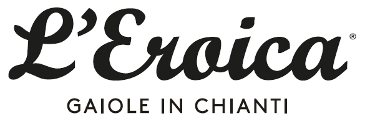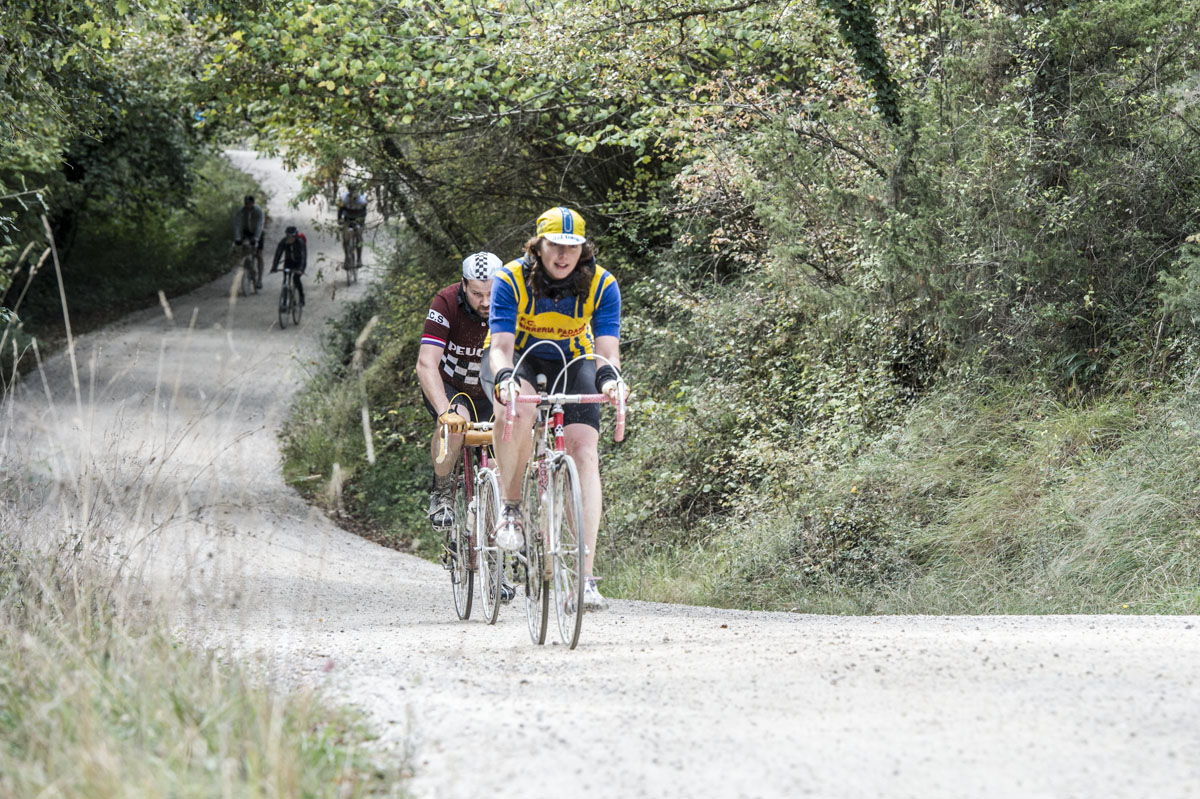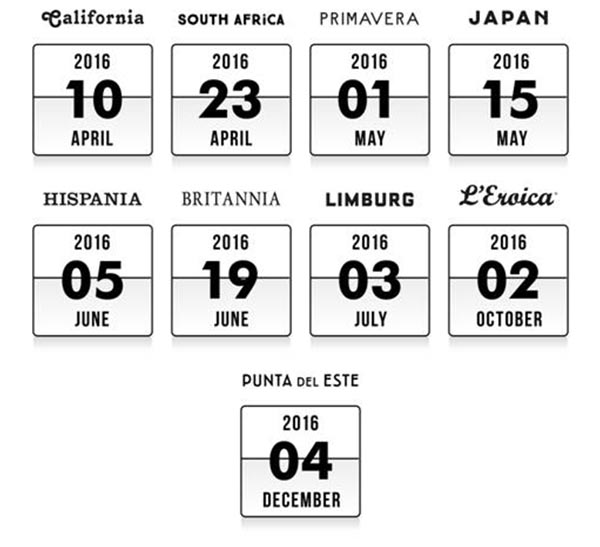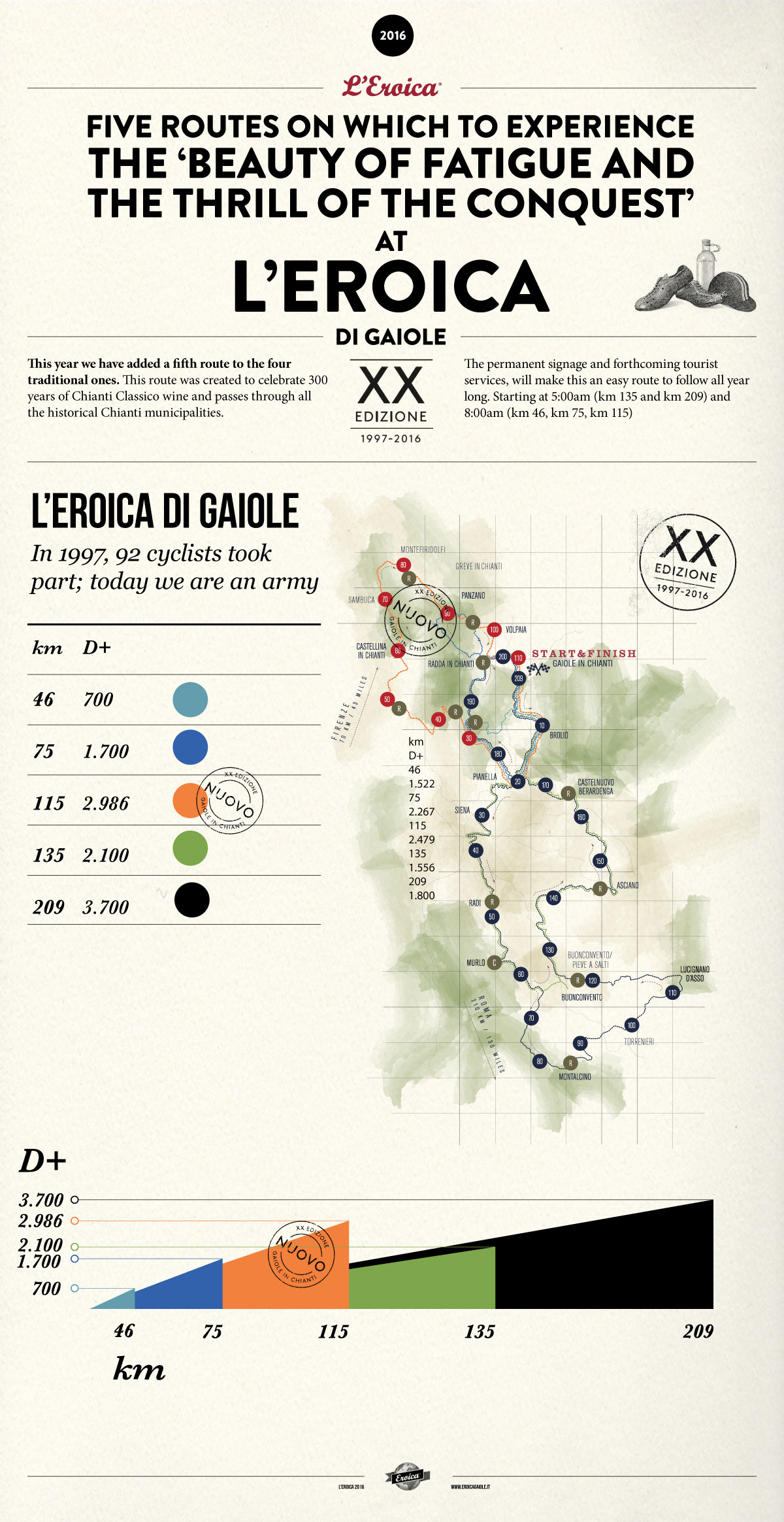
Ecco i cinque percorsi dell’Eroica 2016; ognuno potrà provare il gusto dell’impresa e gustare la bellezza della fatica
La leggenda del Gallo Nero che decise il confine tra Firenze e Siena
Gaiole in Chianti (SI), 28 settembre 2016 - I percorsi de L’Eroica sono come quelli attuali da almeno un decennio, salvo piccole modifiche. Una delle modifiche più importanti ebbe luce dalla disponibilità data dal Barone Ricasoli al passaggio davanti al Castello di Brolio, attraverso la famosa strada costeggiata da cipressi e diventata, negli anni, una delle icone de L’Eroica, con le fiaccole ad illuminarne i bordi nelle ore prima dell’alba. L’anno scorso è stato modificato seppur di poco, il percorso da 46 km, con il piccolo allungamento verso Dievole. Da un paio di anni è stata abbandonata la strada bianca di Montauto, tra Monteroni d’Arbia e Asciano, ormai impraticabile con bici d’epoca, sostituita con la altrettanto bella e panoramica strada asfaltata della Campana. La leggenda del Gallo Nero che decise il confine tra Firenze e Siena
Quest’anno abbiamo inserito un quinto percorso. Il Consorzio, in occasione dei festeggiamenti per i 300 anni di storia del Chianti Classico, ha fortemente voluto un percorso di media lunghezza che attraversasse tutti i comuni del Chianti storico, con l’obiettivo di farne l’ossatura di un tracciato cicloturistico dal quale, con piccole digressioni, raggiungere la maggior parte delle migliori cantine del territorio. La successiva frecciatura permanente e la messa a sistema dei relativi servizi turistici ne agevolerà la fruizione durante tutto l’anno.
Percorso km 46
E’ il percorso che tradizionalmente scelgono i neofiti de L’Eroica, il più facile ma comunque d’un certo impegno. Condivide con tutti gli altri percorsi la fase iniziale di circa 20 km passando dal Castello di Brolio per poi pianare su Pianella, dopo una sosta fotografica presso il “Leccione” del 17° chilometro.
Abbiamo confermato il piccolo allungamento, quasi tutto su strada bianca, per passare attraverso le vigne e i casali di Dievole, una delle più belle zone di produzione del Chianti Classico. In totale saranno 46 km. I primi 26 e gli ultimi 9 saranno identici al passato.
Percorso km 75
Percorso interamente all’interno delle zone di produzione del Chianti Classico, con i “must” dei passaggi dal Castello di Brolio, da Vagliagli e la vallata dell’Arbia ancora giovane, il centro storico di Radda in Chianti che si trasforma per l’occasione in un paesino d’altri tempi, con il popolo in costume ad offrire ristoro e assistenza ai ciclisti de L’Eroica. La stessa cosa farà a Panzano il Cecchini, il re della “ciccia”. Dopo aver affrontato la parte più dura del percorso, attraverso lo sterrato che conduce verso il poggio di Volpaia, vi aspetterà il ristoro più rinomato de L’Eroica, in uno dei casali della Fattoria di Lamole. Non riuscirete a stare leggeri perché resistere al piatto di ribollita che vi aspetta sarà dura. Ma poi le strade favorevoli verso la Villa di Radda, San Donato in Perano, Vertine, con le viste sul traguardo finale di Gaiole, vi faranno letteralmente estasiare.
Percorso km 115
Il nuovo percorso transiterà per tutti i comuni del Chianti Classico. Sarà identico agli altri percorsi chiantigiani fino alle prime case di Vagliagli, quando devierà a sinistra, subito duro, attraverso una rampa al 12%. Si proseguirà poi in cresta, su strada bianca, fino quasi a Castellina in Chianti per poi discendere attraverso Fonterutoli e San Leonino fino a Lilliano, Bibbiano e Fizzano. Poi Cispiano e Sante Dame. Nel tratto da Bibbiano a Sante Dame, quasi tutto di strada bianca, si salirà con pendenze anche oltre il 26%. Fonterutoli è il punto dove fu tracciato il confine tra le Repubbliche di Siena e Firenze. La leggenda narra che, nel periodo in cui le due repubbliche si contendevano il territorio del Chianti, deciso di tentare di dare fine alle dispute e stabilire un confine definitivo adottando un sistema singolare. Fu stabilito di far partire all’alba dai rispettivi capoluoghi due cavalieri e di fissare il confine nel loro punto d’incontro. Il via sarebbe stato dato dal canto del gallo. Scelta in accordo con le usanze del tempo, quando i ritmi erano dettati dalla natura. La “giuria” assegnò un gallo ciascuno ai due contendenti, libera fu la scelta del destriero e del cavaliere. I senesi ebbero in sorte un gallo bianco, i fiorentini uno nero, che tennero al buio e quasi a digiuno per diversi giorni. Il giorno convenuto per la partenza, non appena fu liberato, il gallo nero cominciò a cantare fortemente anche se l’alba era ancora lontana. Il cavaliere fiorentino partì così molto prima dell’alba, con grande vantaggio su quello senese, che dovette attendere le prime luci del giorno, quando il suo gallo, regolarmente, cantò. Il cavaliere senese percorse solo poche miglia in solitudine e incontrò il cavaliere fiorentino appunto a Fonterutoli. Fu così che il Gallo Nero divenne il simbolo delle Lega del Chianti e poi il simbolo del vino più conosciuto al mondo.
Tornando al percorso, dopo Pietracuta, su asfalto, si passerà dalla sede del Consorzio del Chianti Classico a Sambuca e poi dalla salita di Fabbrica, Tignanello. Si ricomincia con le strade bianche da Santa Maria a Macereta e, sfiorando la Badia a Passignano, si sale a Testalepre con punte del 18/20%.
Da Testalepre, proseguendo sullo spartiacque Pesa/Greve, ci si ricongiungerà con il percorso da 75 chilometri a Panzano, per arrivare al tradizionale ristoro di Lamole, dove si potranno ritrovare gli amici che avranno scelto di fare meno chilometri.
Percorso km 135
Si cambia totalmente scenario. La partenza all’alba, il passaggio da Brolio in chiaroscuro illuminato dalle fiaccole a olio, il sole che sorge mentre si incominciano a vedere le torri di Siena all’orizzonte. Emozioni che vi resteranno, indelebili, nella mente e nel cuore. Poi Murlo, con il passaggio attraverso il Castello, i cui abitanti pare conservino nel loro sangue l’ultimo DNA etrusco. La Valdarbia e le Crete di Asciano, lo spauracchio del Monte Sante Marie, il rientro in Chianti. Perderete molto tempo per guardarvi intorno ma a L’Eroica il tempo non conta.
Percorso km 209
Fino alla Valdarbia, strade e sensazioni saranno le stesse del percorso da 135. Poi il gioco si farà duro. Si salirà verso Montalcino da Castiglion del Bosco, la salita santificata dall’arrivo del Giro del 2010, quando i ciclisti avevano tutti la maglia dello stesso colore, quello del fango. Si riprenderà poi fiato anche grazie al tempo che potrete dedicare a buttare un occhio a destra e a manca per godere delle viste sulla Valdorcia che vi si pareranno davanti, fino a ritornare a Buonconvento attraverso Pieve a Salti. Luoghi che molti conoscono già grazie a Eroica Primavera. Poi ci si ricongiungerà con il percorso da 135km, per Asciano, Monte Sante Marie, Castelnuovo Berardenga, Radda. Quando riuscirete a vedere le prime case di Gaiole scendendo da San Donato e Vertine, anche se saranno illuminate nella notte, potrete incominciare ad assaporare l’emozione di potervi definire “veri eroici”!


Here are the five routes of L'Eroica 2016: everyone will be able to experience the thrill of the conquest and savour the beauty in fatigue
The legend of the Black Rooster that decided where the border between Florence and Siena would be
Apart from some small variations, the L’Eroica routes have been the same for at least a decade. One of the most significant changes came about when Baron Ricasoligave his permission to pass by Brolio Castle, along the famous cypress-flanked avenue lit only by torches in the first light of dawn, which has become a L’Eroica icon over the years. Last year, the 46 km route was slightly modified by adding Dievole. The Monauto white road, between Monteroni d’Arbia and Asciano was abandoned two years ago because it was impassable on a vintage bike. It was substituted by the equally panoramic tar road to Campana. The legend of the Black Rooster that decided where the border between Florence and Siena would be
This year, we have inserted a fifth route. To celebrate 300 years of Chianti Classico wine, the Consortium wanted a route that would pass through all the historical Chianti municipalities. The aim is to develop this route into a cycle track that will allow tourists, with short detours, to reach most of the best wine cellars in the region. The permanent signage and relative tourist services to come, will make this an easy route to follow all year long.
Route km 46
This is the route that is usually chosen by L’Eroica novices, it is the easiest route but still requires some effort. About the first 20 km of this route are the same as the others, passing Castello di Brolio before continuing on to Pianella, stopping en route for a photo at the “Leccione” (large oak tree) at the 17 km mark.
We have maintained the short stretch that we added last year, almost all along white roads, which will take you through the vineyards and castles of Dievole, one of the most beautiful Chianti Classico producing areas. The route consists of 46 km in total, the first 26 km and the last 9 km identical to past years.
Route km 75
This route is entirely within the Chianti Classico producing region. The “musts” on the route are the Castello di Brolio, Vagliagli and the Arbia valley, the old centre of Radda in Chianti that turns itself into a town from a bygone era, with all the people dressed up and offering food and assistance to the L’Eroica cyclists. The same treatment will be offered by Cecchini, the king of “ciccia” (meat) in Panzano. After the most difficult section on the route, across the gravel stretch that leads to the Volpaia hill, L’Eroica’s most famous food stop awaits you, in one of the farmhouses of the Fattoria di Lamole. You won’t be able to watch what you eat because it will be almost impossible to resist the bowl of ribollita soup that will be waiting for you. Then, the more favourable roads towards Villa di Radda, San Donato in Perano, Vertine, with views of the finish line in Gaiole, will have you literally in ecstasy.
Route km 115
The new route will go through all the Chianti Classico municipalities. It will be the same as the other Chianti routes up until the first houses of Vagliagli, when this route turns left and becomes difficult straight away, with a 12% gradient. The crest continues along white roads until just before Castellina in Chianti, before descending through Fonterutoli and San Leonino, Lilliano, Bibbiano and Fizzano. Then it’s on to Cispiano and Sante Dame. In the section between Bibbiano and Sante Dame, which is almost entirely on white roads, climbs can be over 26%.
Fonterutoli is where the border between the Republics of Siena and Florence was marked out. Legend tells us that when the two republics were contending the Chianti territories, they decided on an unusual system to end their disputes by establishing a clearly defined border. It was established that two knights would set off from their respective cities at dawn and that the border would be drawn at the place where they met. They were to set off at cockcrow, according to the customs of the time, when nature dictated the rhythm of life. The ‘jury’ assigned a rooster to each contender and they were free to choose their own knight and steed. The Sienese party were given a white rooster, while the Florentines got a black one, which they kept in the dark and almost without food for several days. On the agreed day, as soon as he was freed, the black rooster began to crow loudly even though it was well before dawn. Thus, the Florentine knight set off long before dawn and long before the Sienese knight who had to wait until the first light of day when the white rooster naturally crowed. The Sienese knight had, in fact, only covered a few miles when he met his Florentine counterpart at Fonterutoli. That is how the Black Rooster became the symbol of the Chianti League and subsequently the symbol of the best-known wine in the world.
Back on the road, after Pietracuta, all along tar roads, the route passes by the Chianti Classico Consortium in Sambuca and uphill by Fabbrica and Tignanello. It’s back onto the white roads from Santa Maria to Macereta and, skimming past Badia a Passignano, the route climbs to Testalepre with 18/20% gradients.
From Testalepre, continuing along the road between Pesa and Greve, the riders will rejoin the 75 km route in Panzano, at a traditional Lamole food stop, where they will be able to meet up with friends who opted for the shorter route.
Route km 135
Now we have a complete change of scenery: setting off at dawn, passing Brolio in the half-light, illuminated only by torches, the sun rising as you start to glimpse the towers of Siena on the horizon. This experience will stay with you forever, making an indelible mark on your heart and mind. Later, pass through the Castle of Murlo, whose habitants apparently conserve the last Etruscan DNA in their blood, then it’s on to Valdarbia and the Crete di Asciano, the fearsome Monte Sante Marie, before returning to the Chianti region. You will waste time taking in the scenery, but time is not important at L’Eroica.
Route km 209
Up to Valdarbia, the roads and sensations are the same as for the 135 km route. Then, the going gets tough. Climb up towards Montalcino from Castiglion del Bosco, the climb that was sanctified by the Giro in 2010, when the cyclists all finished with jerseys of the same colour – the colour of mud! Then, you can draw breath and dedicate some time to looking around at the views of the Valdorcia that will appear before you. After that, it’s back to Buonconvento, through Pieve a Salti, places that are well known to many of you, thanks to Eroica Primavera. Rejoin the 135 km route covering: Asciano, Monte Sante Marie, Castelnuovo Berardenga and Radda. When you start to see the first houses of Gaiole, on your way down from San Donato and Vertine, even if they are lit up because it’s already night, you can proudly claim to be a ‘vero Eroico’, a true hero!

L'Eroica could only have been born in Tuscany. It’s a matter of soul, of land, white roads, landscapes, of genuine food and wine, of culture and passions, of history and of Bartali. Now world-renowned for the special people it involves and for the values it upholds, Eroica encapsulates the very essence of Tuscany, a place that offers a lifestyle that looks to the future, without neglecting its identity and its environment, while also seeking to rediscover the authentic roots of the great sport that is cycling.

;
JARNO WIDAR VINCE IL GIRO NEXT GEN A MATTHEW BRENNAN LA TAPPA FINALE
TADEJ POGACAR ha vinto il GIRO D'ITALIA edizione 107 - TIM MERLIER [...]
LA MAGLIA ROSA TADEJ POGACAR VINCE LA VENTESIMA TAPPA DEL GIRO [...]
ANDREA VENDRAME VINCE LA DICIANNOVESIMA TAPPA DEL GIRO D’ITALIA [...]
© 2025 Bikenews - Testata giornalistica regolarmente registrata - redazione@bikenews.it - Direttore Bruno Achilli - Editore / Photo / Press Andrea Magnani




